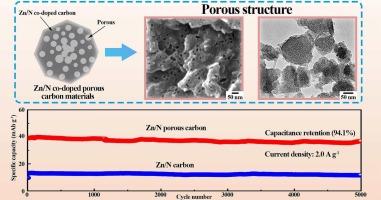用于高性能锌离子电容器的金属-有机骨架zif -8衍生Zn/N共掺杂多孔碳
IF 5.1
3区 材料科学
Q2 MATERIALS SCIENCE, COATINGS & FILMS
引用次数: 0
摘要
含水锌离子电容器具有许多优点,包括增强的功率密度和安全性,低成本。然而,锌离子电容器的能量密度仍然受到正极材料储能能力的限制。在本研究中,我们以有机金属聚合物为前驱体,纳米二氧化硅为成孔添加剂,合成了一种锌/氮共掺杂多孔碳材料。分析结果表明,制备的碳材料具有均匀的Zn/N原子分布,优异的比表面积(2226.1 m2 g−1)和均匀的多孔结构。Zn/N原子的掺入和丰富的孔隙增强了碳材料的离子吸附位点,同时也促进了锌离子的扩散。因此,与对照样品相比,Zn/N共掺杂多孔碳作为锌离子电容器的正极材料具有显著增强的电化学性能。动态行为分析进一步表明,多孔结构对激活碳材料的电化学性能起着至关重要的作用。这项工作为开发具有优异电化学性能的锌离子电容器正极材料提供了一条基本途径。本文章由计算机程序翻译,如有差异,请以英文原文为准。

Metal-organic framework ZIF-8-derived Zn/N Co-doped porous carbon for high-performance zinc-ion capacitors
Aqueous zinc-ion capacitors offer several advantages, including enhanced power density and safety, low cost. However, the energy density of zinc-ion capacitors is still constrained by the energy storage capacity of cathode materials. In this study, we synthesized a zinc/nitrogen co-doped porous carbon material by utilizing an organometallic polymer as precursor and nano-silica as pore forming additive. Impressively, the analysis results reveal that prepared carbon material is equipped with the uniform distribution of Zn/N atoms, splendid specific surface area (2226.1 m2 g−1) and homogeneous porous architecture. The incorporation of Zn/N atoms and abundant pores enhance the ion adsorption sites of carbon materials, while also facilitating the diffusion of zinc ions. Thus, the Zn/N co-doped porous carbon as cathode material for zinc-ion capacitors delivers significantly enhanced electrochemical performance compared with the contrast sample. The dynamic behavior analysis further demonstrates that porous structures play a crucial role in activating the electrochemical performance of carbon materials. This work represents a fundamental approach for the development of cathode materials with superior electrochemical properties for zinc-ion capacitors.
求助全文
通过发布文献求助,成功后即可免费获取论文全文。
去求助
来源期刊

Diamond and Related Materials
工程技术-材料科学:综合
CiteScore
6.00
自引率
14.60%
发文量
702
审稿时长
2.1 months
期刊介绍:
DRM is a leading international journal that publishes new fundamental and applied research on all forms of diamond, the integration of diamond with other advanced materials and development of technologies exploiting diamond. The synthesis, characterization and processing of single crystal diamond, polycrystalline films, nanodiamond powders and heterostructures with other advanced materials are encouraged topics for technical and review articles. In addition to diamond, the journal publishes manuscripts on the synthesis, characterization and application of other related materials including diamond-like carbons, carbon nanotubes, graphene, and boron and carbon nitrides. Articles are sought on the chemical functionalization of diamond and related materials as well as their use in electrochemistry, energy storage and conversion, chemical and biological sensing, imaging, thermal management, photonic and quantum applications, electron emission and electronic devices.
The International Conference on Diamond and Carbon Materials has evolved into the largest and most well attended forum in the field of diamond, providing a forum to showcase the latest results in the science and technology of diamond and other carbon materials such as carbon nanotubes, graphene, and diamond-like carbon. Run annually in association with Diamond and Related Materials the conference provides junior and established researchers the opportunity to exchange the latest results ranging from fundamental physical and chemical concepts to applied research focusing on the next generation carbon-based devices.
 求助内容:
求助内容: 应助结果提醒方式:
应助结果提醒方式:


